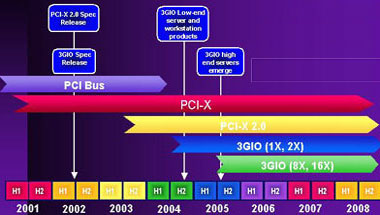Op het Intel Developer Forum dat op dit moment plaatsvindt worden natuurlijk niet alleen nieuwe processors getoond, zo is er bijvoorbeeld een hoop informatie te vinden over toekomstige I/O standaarden zoals Serial ATA, 3GIO/Arapahoe en AGP8x. De roadmap die is getoond voor de verschillende busstandaarden laat zien dat we onze PCI kaarten de komende jaren nog niet hoeven te vervangen. Pas in de loop van 2004 zal PCI vervangen worden door 3GIO 1x en 2x. Inderdaad, net als bij AGP het geval is maakt de nieuwe standaard gebruik van een soort "multiplier" in de naam om de versie/bandbreedte aan te duiden. Zo zullen er rond de helft van 2005 bijvoorbeeld 3GIO 8x en 16x worden geïntroduceerd voor zware servers. Ondanks deze snelle groei van capaciteit van 3GIO zal PCI nog lang niet helemaal verdwijnen, in de vorm van PCI-X en PCI-X 2.0 zal deze standaard nog minstens tot 2008 actief blijven. Hieronder een voorbeeldje van een 3GIO chipset:
Interestingly, the 3GIO and AMD HyperTransport coexits together for interconnecting the Northbridge and the Southbridge. 3GIO serves more functions like connecting to the graphics and the expansion devices. Arapahoe working group is working to shift the common Accelerated Graphics Port to the 3GIO or "Arapahoe" serial bus. The next-generation AGP 8X or AGP 3.0 standard will be the last for AGP then 3GIO will take over. AGP 3.0 is defined as a 32-bit wide parallel bus clocked at 533-MHz, for a total bandwidth of about 2.1 Gbytes per second. 3GIO will be a serial point-to-point interconnect, capable of scaling from 1- to 32-bits wide. The total bandwidth per pin is initially targeted at 2.5 Gbits/s per pin which could then be clocked higher in future updates.
[break]Verder heeft Seagate officiëel de Serial ATA interface aangekondigd. De eerste prototypes van hotpluggable ATA-600 schijven werden getoond, met daarbij de meldig dat de hele Barracuda ATA serie al is voorbereid op de nieuwe standaard. Het wachten is op de chipsetmakers, die de eerst nog ATA-150 controllers op de markt moeten gaan zetten. Serial ATA zou goedkoper moeten zijn dan de huidige parallele interface en is in tegenstelling tot de meeste andere getoonde innovaties volledig backwards compatible met zijn voorgangers:[/break]
Built for the future from the ground up, Serial ATA is the first completely new PC storage interface technology since Parallel ATA technology was introduced 20 years ago. The timing of Serial ATA implementation is ideal. Initial Serial ATA transfer rates above 150 Mbytes per second will be implemented by all major chipset makers well before hard drive transfer rates exceed the capability of the current Ultra ATA/100 interface. In the future, an enhanced breed of Serial ATA for entry server markets will be introduced to enable superset features previously unique to SCSI devices.

